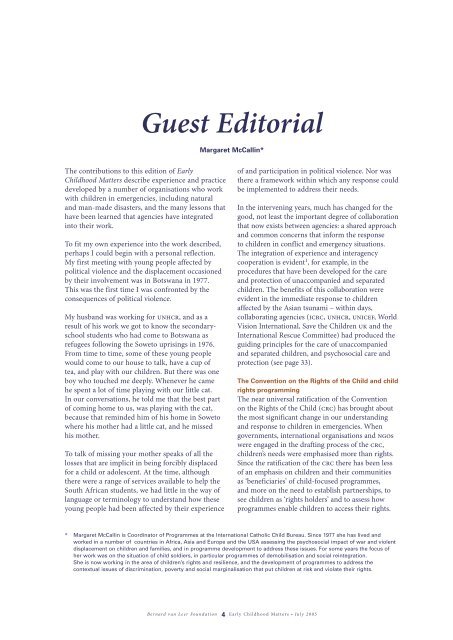Responses to young children in post-emergency situations
Responses to young children in post-emergency situations
Responses to young children in post-emergency situations
You also want an ePaper? Increase the reach of your titles
YUMPU automatically turns print PDFs into web optimized ePapers that Google loves.
Guest Edi<strong>to</strong>rial<br />
Margaret McCall<strong>in</strong>*<br />
The contributions <strong>to</strong> this edition of Early<br />
Childhood Matters describe experience and practice<br />
developed by a number of organisations who work<br />
with <strong>children</strong> <strong>in</strong> emergencies, <strong>in</strong>clud<strong>in</strong>g natural<br />
and man-made disasters, and the many lessons that<br />
have been learned that agencies have <strong>in</strong>tegrated<br />
<strong>in</strong><strong>to</strong> their work.<br />
To fit my own experience <strong>in</strong><strong>to</strong> the work described,<br />
perhaps I could beg<strong>in</strong> with a personal reflection.<br />
My first meet<strong>in</strong>g with <strong>young</strong> people affected by<br />
political violence and the displacement occasioned<br />
by their <strong>in</strong>volvement was <strong>in</strong> Botswana <strong>in</strong> 1977.<br />
This was the first time I was confronted by the<br />
consequences of political violence.<br />
My husband was work<strong>in</strong>g for unhcr, and as a<br />
result of his work we got <strong>to</strong> know the secondaryschool<br />
students who had come <strong>to</strong> Botswana as<br />
refugees follow<strong>in</strong>g the Sowe<strong>to</strong> upris<strong>in</strong>gs <strong>in</strong> 1976.<br />
From time <strong>to</strong> time, some of these <strong>young</strong> people<br />
would come <strong>to</strong> our house <strong>to</strong> talk, have a cup of<br />
tea, and play with our <strong>children</strong>. But there was one<br />
boy who <strong>to</strong>uched me deeply. Whenever he came<br />
he spent a lot of time play<strong>in</strong>g with our little cat.<br />
In our conversations, he <strong>to</strong>ld me that the best part<br />
of com<strong>in</strong>g home <strong>to</strong> us, was play<strong>in</strong>g with the cat,<br />
because that rem<strong>in</strong>ded him of his home <strong>in</strong> Sowe<strong>to</strong><br />
where his mother had a little cat, and he missed<br />
his mother.<br />
To talk of miss<strong>in</strong>g your mother speaks of all the<br />
losses that are implicit <strong>in</strong> be<strong>in</strong>g forcibly displaced<br />
for a child or adolescent. At the time, although<br />
there were a range of services available <strong>to</strong> help the<br />
South African students, we had little <strong>in</strong> the way of<br />
language or term<strong>in</strong>ology <strong>to</strong> understand how these<br />
<strong>young</strong> people had been affected by their experience<br />
of and participation <strong>in</strong> political violence. Nor was<br />
there a framework with<strong>in</strong> which any response could<br />
be implemented <strong>to</strong> address their needs.<br />
In the <strong>in</strong>terven<strong>in</strong>g years, much has changed for the<br />
good, not least the important degree of collaboration<br />
that now exists between agencies: a shared approach<br />
and common concerns that <strong>in</strong>form the response<br />
<strong>to</strong> <strong>children</strong> <strong>in</strong> conflict and <strong>emergency</strong> <strong>situations</strong>.<br />
The <strong>in</strong>tegration of experience and <strong>in</strong>teragency<br />
cooperation is evident 1 , for example, <strong>in</strong> the<br />
procedures that have been developed for the care<br />
and protection of unaccompanied and separated<br />
<strong>children</strong>. The benefits of this collaboration were<br />
evident <strong>in</strong> the immediate response <strong>to</strong> <strong>children</strong><br />
affected by the Asian tsunami – with<strong>in</strong> days,<br />
collaborat<strong>in</strong>g agencies (icrc, unhcr, unicef, World<br />
Vision International, Save the Children uk and the<br />
International Rescue Committee) had produced the<br />
guid<strong>in</strong>g pr<strong>in</strong>ciples for the care of unaccompanied<br />
and separated <strong>children</strong>, and psychosocial care and<br />
protection (see page 33).<br />
The Convention on the Rights of the Child and child<br />
rights programm<strong>in</strong>g<br />
The near universal ratification of the Convention<br />
on the Rights of the Child (crc) has brought about<br />
the most significant change <strong>in</strong> our understand<strong>in</strong>g<br />
and response <strong>to</strong> <strong>children</strong> <strong>in</strong> emergencies. When<br />
governments, <strong>in</strong>ternational organisations and ngos<br />
were engaged <strong>in</strong> the draft<strong>in</strong>g process of the crc,<br />
<strong>children</strong>’s needs were emphasised more than rights.<br />
S<strong>in</strong>ce the ratification of the crc there has been less<br />
of an emphasis on <strong>children</strong> and their communities<br />
as ‘beneficiaries’ of child-focused programmes,<br />
and more on the need <strong>to</strong> establish partnerships, <strong>to</strong><br />
see <strong>children</strong> as ‘rights holders’ and <strong>to</strong> assess how<br />
programmes enable <strong>children</strong> <strong>to</strong> access their rights.<br />
* Margaret McCall<strong>in</strong> is Coord<strong>in</strong>a<strong>to</strong>r of Programmes at the International Catholic Child Bureau. S<strong>in</strong>ce 1977 she has lived and<br />
worked <strong>in</strong> a number of countries <strong>in</strong> Africa, Asia and Europe and the USA assess<strong>in</strong>g the psychosocial impact of war and violent<br />
displacement on <strong>children</strong> and families, and <strong>in</strong> programme development <strong>to</strong> address these issues. For some years the focus of<br />
her work was on the situation of child soldiers, <strong>in</strong> particular programmes of demobilisation and social re<strong>in</strong>tegration.<br />
She is now work<strong>in</strong>g <strong>in</strong> the area of <strong>children</strong>’s rights and resilience, and the development of programmes <strong>to</strong> address the<br />
contextual issues of discrim<strong>in</strong>ation, poverty and social marg<strong>in</strong>alisation that put <strong>children</strong> at risk and violate their rights.<br />
B e r n a r d v a n L e e r Fo u n d a t i o n 4 E a r l y C h i l d h o o d M a t t e r s • Ju l y 2 0 0 5
















